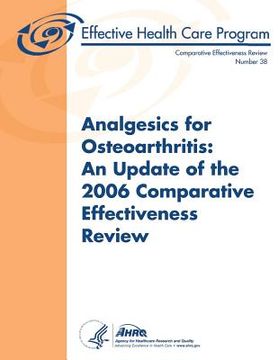Analgesics for Osteoarthritis: An Update of the 2006 Comparative Effectiveness Review: Comparative Effectiveness Review Number 38 (in English)
Synopsis "Analgesics for Osteoarthritis: An Update of the 2006 Comparative Effectiveness Review: Comparative Effectiveness Review Number 38 (in English)"
Osteoarthritis is a chronic condition involving degeneration of cartilage within the joints. It is the most common form of arthritis and is associated with pain, substantial disability, and reduced quality of life. Surveys indicate that 5 to 17 % of U.S. adults have symptomatic osteoarthritis of the knee, and 9 % have symptomatic osteoarthritis of the hip. Osteoarthritis is more common with older age. The total costs for arthritis, including osteoarthritis, may be greater than 2 % of the gross domestic product, with more than half of these costs related to work loss. Common oral medications for osteoarthritis include nonsteroidal anti-inflammatory drugs (NSAIDs) and acetaminophen. Patients with osteoarthritis also use topical agents, and over-the counter oral supplements not regulated by the U.S. Food and Drug Administration (FDA) as pharmaceuticals, including glucosamine and chondroitin. Opioid medications are also used for selected patients with refractory, chronic pain but are associated with special considerations related to their potential for addiction and abuse and were not included in this review. Each class of medication or supplement included in this review is associated with a unique balance of risks and benefits. In addition, benefits and harms may vary for individual drugs within a class. Nonpharmacologic interventions (physical therapy, weight reduction, and exercise) also help improve pain and functional status in patients with osteoarthritis, but were outside the scope of this review. A challenge in treating osteoarthritis is deciding which medications will provide the greatest symptom relief with the least harm. NSAIDs decrease pain, inflammation, and fever by blocking cyclooxygenase (COX) enzymes. NSAIDs are thought to exert their effects primarily through blocking different COX isoenzymes, in particular COX-1 and COX-2. By blocking COX-2, NSAIDs reduce pain compared with placebo in patients with arthritis, low back pain, minor injuries, and soft-tissue rheumatism. However, NSAIDs that also block the COX-1 enzyme (also called "nonselective NSAIDs") can cause gastrointestinal (GI) bleeding. The number of deaths in the United States due to use of non-aspirin NSAIDs is not known with certainty. One study estimated the number at 3,200 annually in the 1990s, though other studies have reported higher estimates. Theoretically, NSAIDs that block only the COX-2 enzyme (also called "coxibs," "COX-2 selective NSAIDs," or "selective NSAIDs") should be safer with regard to GI bleeding, but were found to increase the risk of serious cardiovascular (CV) and other adverse events. This comparative effectiveness review is to update the previous report that assessed the comparative efficacy and safety of nonopioid oral medications (selective and nonselective non-aspirin NSAIDs, aspirin, salsalate, and acetaminophen), over-the-counter supplements (chondroitin and glucosamine), and topical agents (NSAIDs and rubefacients, including capsaicin) for osteoarthritis. Key Questions include: KQ1: What are the comparative benefits and harms of treating osteoarthritis with oral medications or supplements? How do these benefits and harms change with dosage and duration of treatment? The only benefits considered here are improvements in osteoarthritis symptoms. Evidence of harms associated with the use of NSAIDs includes studies of these drugs for treating osteoarthritis or rheumatoid arthritis and for cancer prevention. KQ2: Do the comparative benefits and harms of oral treatments for osteoarthritis vary for certain demographic and clinical subgroups of patients? KQ3: What are the comparative effects of coprescribing H2 receptor antagonists, misoprostol, or proton pump inhibitors (PPIs) on the gastrointestinal harms associated with NSAID use? KQ4: What are the comparative benefits and harms of treating osteoarthritis with oral medications compared with topical preparations, or of different topical medications compared with one another?

